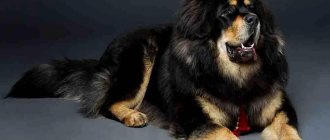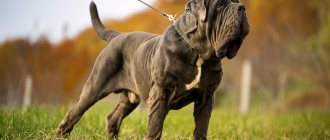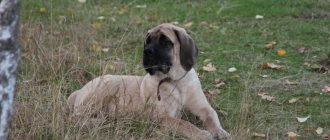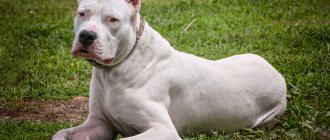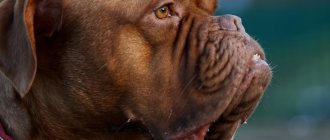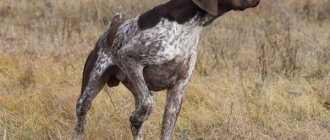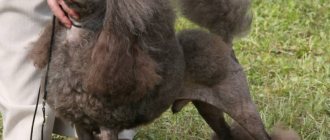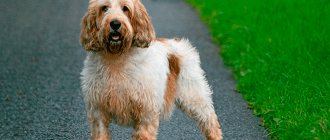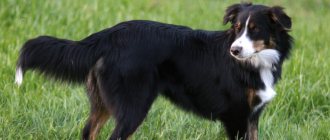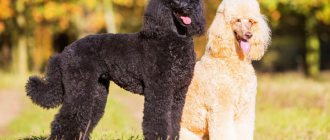Tibetan Mastiff, as this unusual breed of dog is called by the English-speaking inhabitants of the planet, is a large furry creature with a wise and hardy character.
Born in the harsh mountainous conditions of Nepal and Tibet, they were called upon to become reliable protectors of the entire family, livestock and other property of local residents.
At first glance at the photo of a Tibetan mastiff, an involuntary thought arises in your head: What an amazing bear cub!
But don’t rush to hasty conclusions and realize the urgent, burning desire to acquire such a big and sweet friend.
Features and description
The Tibetan Mastiff breed is very rare. When China was isolated from other countries, breeders actively bred such dogs. Thanks to this, they managed to preserve their unique appearance and original character. As a security guard and bodyguard, this furry giant has no equal. Its dimensions are truly impressive.
But an intimidating appearance is not the only parameter that stops potential attackers. The dog is intimidating with its menacing bark and demonstration of readiness to attack. She is also a good bodyguard, lovingly caring for the safety of her owner.
The first people who began to have these dogs for protection were Tibetan monks. They understood that they could not find better four-legged pets in all of Asia. These animals have always been not only effective in terms of protection, but also gentle. Such a dog sincerely becomes attached to each of the members of its pack.
She happily expresses admiration and even respect to everyone. In general, he does not skimp on expressing emotions. It is not easy to survive in the mountainous climate of Tibet, so nature took care of the animals living there. She awarded the mastiff a fluffy fur coat with insulating properties.
Interesting! According to experts, many modern large dogs, including St. Bernards and Rottweilers, are descended from the Tibetan mastiff.
The dog in question has a low voice. That is why her barking causes fear and sometimes horror among those around her. The interesting thing is that the dog does not have to be taught to intimidate strangers with a low voice; he will do it himself, regardless of whether the owner is nearby or not.
He quickly learns to separate his family's territory from that of others. He carefully and bravely guards it, does not compromise, always relies on the owner, but if he is not nearby, he can independently make an important decision, for example, to attack a robber.
Now the reader may have a false opinion about the supposedly evil nature of the Tibetan Mastiff. In fact, this is one of the kindest dogs that gets along well in the same territory not only with people, but also with their pets. He will never offend his owner or his children, as he sincerely becomes attached to them and strives to protect them.
General pros and cons
Advantages inherent in mastiffs:
- calm character;
- fearlessness, readiness to always rush to the owner’s defense;
- constant care for the owner and family members.
There are also common negative features:
- early socialization is necessary;
- there is a tendency to show independence;
- don't like loneliness.
Once you decide to get a mastiff, think about whether you can become a good owner for him. And if not, then it’s better not to risk it: this dog is very affectionate and does not tolerate a change in its main patron and friend.
Additionally, check out a short video about the mastiff breed:
The Mastiff is one of the oldest dog breeds, known even before our era.
The family includes several independent species, and all of them are among the largest and most powerful dogs in the whole world.
Despite their formidable appearance, representatives of the breed have a balanced and calm character and are distinguished by good intellectual abilities.
Let's consider the main features and characteristics of the majestic breed.
Breed standard
The Tibetan Mastiff dog is large, very strong and tall. She has the most powerful bones, a physically powerful body and a serious character. Sexual dimorphism is well expressed - females are significantly inferior to males in weight and height. The height at the withers of the former is from 55 to 61 cm, and of the latter – from 63 to 67 cm. The female weighs from 50 to 53 kg, the male – from 58 to 63 kg.
The muscles on the body are dry and elastic. The back is flat, but there is a sharp transition to the lower back. The slightly sloping croup also has powerful muscles. The neck is short and has a large dewlap. The withers are also perfectly defined. There is a dense scruff.
The sternum is deep. The ribs can be easily felt, but they are not visible due to the thick coat. The set of the tail is medium in thickness - high. According to the standard, he should lie on his back. The dog's peritoneum is tightened. The legs are compact, spaced at an equal distance from each other, resting on pads.
The dog's head is large, the skull is wide. Sometimes shallow wrinkles form on the forehead. The older the individual, the more the fold of skin sags above its eye. The muzzle is square in shape, with a large nose at the tip. A powerful jaw with tenacious sharp teeth.
The bite is straight. The ears are small, rounded at the ends. When the animal is excited, they straighten a little on the cartilages. According to the standard, a representative of the breed must have sagging cheeks, they are moist and thick. Pigmentation of the gums is black and pink.
The Tibetan Mastiff in the photo looks like a miniature lion. He is as strong and fluffy as the king of beasts, and also has a scruff. The dog's coat is long, thick, and has insulating properties. According to the standard, it must be straight; waviness is extremely undesirable. The dog moves confidently and smoothly. There is a sense of strength and greatness in every step she takes. Her step is sweeping. Acceptable colors:
- Black and yellow.
- Black and red.
- Coffee.
- Gray or silver.
- Sable.
- Pale yellow.
- Red-red.
It is important that the animal’s fur is shiny and clean, that is, without any marks. The presence of a small light spot on the sternum is not considered a defect.
Dimensions and weight
Hong Dong's officially declared weight is 113 kg, his height at the withers is 100 cm . For comparison, it is worth noting that the average height of Tibetan Mastiff males is from 66 to 76 cm, weight is 60-80 kg.
Hong Dong compared to a human
The average weight of an adult is 62 kg; for North Americans this figure is 80 kg.
Hong Dong's weight is 113 kg.
The average height of a person is 178 cm. Hong Dong's height at the withers is 100 cm.
Character
Externally, the Tibetan mastiff is formidable, aggressive, in a word, dangerous. But this appearance does not coincide much with his character. In fact, such a dog is incredibly friendly and loving. She likes to feel people's gaze on her, and if they ignore her, she will persistently demand attention.
Loves to spend time with its owners, especially if they leave the house. Feels great in almost any environment. Veterinarians note that the representative of the breed in question behaves restrained and obedient at the reception. This is due to his desire to trust people.
The dog loves his owner and all members of his family very much. He treats each member of the household tenderly, openly expresses his affection and interest in communicating with them. Loves when people touch her. Loves scratching behind the ear and stroking the body. Prefers to be near members of its pack and does not tolerate loneliness well. The character of such a dog can be called soft.
He is not prone to accumulating resentment; on the contrary, he always forgives, even if he was very upset the day before. It is interesting that the older the mastiff gets, the less they express emotions and feelings, that is, they become more restrained with age.
However, no matter what gender and age such a dog is, she spends time with the kids with great joy. She especially likes noisy and active games. Mastiff puppies are especially playful, running and barking a lot.
As the dog grows up, he begins to understand that the people he lives with need his protection. He also strives to protect his and their territory. It is not necessary to teach him this, since he is endowed with protective potential by nature.
In the presence of strangers, he behaves with restraint and carefully looks at everyone. Treats almost all strangers with suspicion and distrust. When a guest comes to the house, he may be barked by a dog. It is not recommended to scold her for this, because by expressing mistrust to an outsider, she is performing watchdog “work.”
In relation to other dogs, they are more loyal and temperamental than cautious and aggressive. Since they understand that few can compare with them in terms of power, they do not try to behave carefully. Usually they watch smaller dogs with interest and can even play with them. And if some bully expresses distrust of them, they will most likely leave silently, ignoring him.
These unique dogs are capable of showing people their respect. For example, if they feel strong gratitude or affection for an individual, they may go up and bow their head to him. Rarely make eye contact.
Important! We do not recommend looking your pet in the eyes if you do not intend to quarrel with him. He will perceive prolonged visual contact as a challenge. And your friendly behavior at this moment will make him feel awkward.
The breed adapts well to any conditions. A change of place of residence will not upset him at all, but it is extremely important that the owner be with him during significant life changes.
The Mastiff is a companion dog that will literally follow on the heels of a loved one. Selects as owner a person with clear leadership potential. Successful in learning, effectively remembers new information.
How to choose a Tibetan Mastiff puppy
The main thing in choosing a purebred puppy is its behavior. This is exactly what you need to pay attention to. The healthiest purebred puppies are the most active and strong in the litter. A small mastiff whose character is too aggressive and restless, this can be an alarm bell and a reason to refuse to choose a specific individual. Still, this indicates instability of the nervous system.
If you decide to get a Tibetan with a good pedigree, you should not lose sight of the gender of the puppy. Females are calmer and more docile, get sick less often, are smaller in size and more sensitive to the owner, while males are much more aggressive and active than females.
In practice, it becomes impossible to acquire an adult mastiff due to the fact that by their nature they become attached to their first owner and have a very difficult time making contact with strangers.
Care and maintenance
When you look at a huge fluffy dog, it’s hard to think that he will settle comfortably in an apartment. Of course, the ideal housing option for him is street. Guard dogs from the group of service dogs are mainly owned by owners of private houses who have a large plot of land and valuable property. For those who live in an apartment, it is better to get a small dog, for example, a Yorkshire terrier or a Maltese.
There is no need to worry that a dog with a lion's mane will freeze in winter when spending the night outside. It has a dense undercoat and long fur that protects against severe frosts. But in the summer, such a “fur coat,” on the contrary, is very disturbing. Therefore, we recommend equipping an enclosure for your large pet on the site. It should be located near the gate.
By the way, about fencing the site. In a house that has a large guard dog like a mastiff, we recommend installing a high gate that he cannot jump over or break. The booth that will be built in the enclosure should be large and comfortable. You can cover it with something soft or just put hay on the floor.
Since a representative of the breed does not tolerate heat very well due to its long and insulating coat, in the summer it can overheat while being outside. Therefore, if the home space allows it, on especially hot days we recommend letting it into the house, but only into the hallway.
Of course, the dog's fur requires special care. It should be thoroughly combed with a brush or iron comb, the main thing is to remove the tangled hairs. If the mastiff's hair is not combed regularly, it will lose its attractiveness and stop shining. You should also definitely wash them with shampoo, 2 to 4 times a year, no more often.
The animal's teeth are cleaned of plaque with a regular brush or laser. The second method is more expensive and requires patience. Large dogs become very anxious when they find themselves on the veterinarian's couch. And laser teeth cleaning makes them uncomfortable. It is not necessary to trim the mastiff's claws, since he moves a lot and grinds them down on his own. But you will definitely have to treat his fur for fleas.
Taking care of your pet
Some owners think that the main problem in keeping a dog is caring for its coat. However, we must remember that Tibetan shepherds hardly carried out grooming and worried about the coat of dogs, which are the most expensive in the world today. The animal learned to take care of itself independently.
Mastiffs are known for their cleanliness. They are excellent at maintaining themselves in the most comfortable state. Such a valuable dog needs careful brushing during shedding. If you plan to exhibit your pet at exhibitions, you will need to constantly work on its appearance. Only in this case will your dog stand on the podium among the winners in the future.
Remember that the dog's fur does not mat. If the animal gets caught in the rain, you need to immediately comb it at home. For this process, experts recommend using a furminator. Regardless of the breed on the street, Tibetans need to be washed 2 times a month. In winter, it is better to use dry shampoo, which is most suitable for your pet's coat.
The Mastiff is a very profitable dog, as it is 100% suitable for yard keeping. The animal does not freeze, loves to take a nap in a snowdrift and loves to swim in the snow. Moreover, it is quite inexpensive to equip a spacious enclosure with a large booth for your beloved pet.
The animal should receive physical activity every day, which will help it maintain joints and muscles in tone. The dog needs to know the entire surrounding area, as he is an excellent watchman.
It is better to walk a mastiff on a harness. At night, you need to open the enclosure so that he walks around the territory entrusted to him. This will be an excellent training for the animal's natural instincts. As mastiff owners in Russia say, at night the dog tirelessly guards the territory, and during the day it shows friendliness and playfulness.
Nutrition
The Tibetan Mastiff is a large dog, so its daily diet should be high-carbohydrate and balanced. His body will actively transform carbohydrates into energy during the day, especially in the first half.
It is not recommended to feed your pet only certain foods, for example, only cereals or meat. He should regularly receive a full complement of nutrients, including fats, carbohydrates and proteins.
A Tibetan Mastiff puppy should eat a lot of raw meat to gradually gain weight and strengthen muscles and bones. He should also drink cow's milk for calcium supplementation. In addition, it is worth additionally feeding it with fruits and vegetables (vitamins and healthy minerals), as well as boiled cereals (amino acids).
Some useful tips for organizing your dog's nutrition:
- Don't give her too hot/cold water.
- Fill the bowl no more than halfway to prevent her from overeating.
- Exclude river fish from her menu.
- Giving sweets is strictly prohibited.
Health
Mastiffs are generally healthy, but representatives of this breed often have cancer, hip and elbow dysplasia, rupture of the anterior cruciate ligament, bloating, subaortic stenosis, skin and coat problems, hypothyroidism and entropion.
- Hip Dysplasia Some dogs have pain and lameness in one or both back legs, but you may also not notice any signs of discomfort in a dog with hip dysplasia. As your dog ages, he may develop arthritis.
- Elbow dysplasia: This condition is common in large breed dogs. It is thought to be caused by different growth rates of the three bones that make up a dog's elbow, which causes ligament weakness and joint instability. This can lead to a painful limp.
- Entropion: This defect, which usually becomes apparent by six months of age, is caused by the eyelid rolling inward, irritating or injuring the eye. One or both eyes may be affected. If your Mastiff has entropion, you may notice him rubbing his eyes. The condition can be corrected with surgery, which is best done after the dog reaches maturity at one or two years of age.
- Cystinuria: This genetic disorder is caused by an inability to reabsorb cystine, an amino acid, back into the kidney tubules. This leads to the formation of kidney or bladder stones, which can cause life-threatening urinary tract blockage, especially in male dogs.
- Gastric dilatation, gastric volvulus, bloating: Commonly called gastric volvulus, this is a life-threatening condition that affects large, deep-chested dogs, especially if they are fed once a day and eat quickly, drink large amounts of water quickly, or after eating intensely training. Bloating occurs when the stomach is stretched by gas or air and then twists.
- Anterior cruciate ligament rupture: This knee injury typically occurs in large, young dogs during play and in older, overweight dogs. A twisting of a dog's hind leg that causes a tear in the anterior cruciate ligament, leading to lameness and then arthritis. Surgery is a form of treatment if the ligament is completely torn.
- Cancer: Dogs, like humans, can develop cancerous tumors. Types of tumors that occur in mastiffs include lymphosarcoma, osteosarcoma, and hemangiosarcoma.
- Panosteitis: This is a short-term condition that occurs in young dogs. Its main sign is sudden lameness, and puppies usually outgrow it by two years of age without any subsequent problems. Lameness can be mild or severe and can be treated with painkillers. Panosteitis is often misdiagnosed as elbow dysplasia, hip dysplasia, patellar luxation, or even more serious conditions. If the diagnosis is misdiagnosed, your veterinarian may perform unnecessary surgery on your dog. If signs appear, seek a second opinion from an orthopedic specialist before allowing surgery.
- Skin Problems: Mastiffs have sensitive skin that is prone to rashes, ulcers and irritation. They may also be predisposed to contact or inhalant allergies caused by reactions to various.
Price
There are quite a lot of mastiff nurseries in Russia; they are in Moscow and St. Petersburg. The cost of a powerful guard dog is not small. The buyer must decide in advance whether he needs a pedigree for the dog; if so, then he will have to set aside at least another 10 thousand rubles.
So, the price of a Tibetan mastiff with documents is from 50 to 65 thousand rubles. This is what breeders demand for puppies with impeccable health. Private owners sell such pets more than 2 times cheaper, from 10 to 25 thousand rubles.
What does an adult dog look like?
An adult Tibetan mastiff looks very majestic and at the same time noble. This is a large, strong, powerful animal, distinguished by a muscular and slightly massive, but at the same time proportional physique. As a rule, these dogs have very long and thick hair, giving the mastiff a resemblance to a lion or bear.
These animals are not characterized by fussiness, but at the same time they are quite energetic and hardy. This is not surprising, given that this breed was bred for a long time only in Tibetan monasteries, and in order to survive in the harsh conditions of the Himalayas, dogs had to have qualities such as strength, mobility and agility.
In Tibetan mastiffs, depending on the type and gender of the dog, the physique can be more or less massive.
Education and training
A guard dog is naturally obedient, but that doesn't mean it doesn't need to be trained. The Mastiff belongs to the group of service dogs, so he always focuses on his owner. It is important to prove to him through deeds your superiority, both psychological and physical. A purebred dog, especially one intended for guard duty, will never obey a person it does not respect.
Important! Never train a representative of the breed on people or animals. Otherwise, his suspicion and basic aggression may increase.
When training a Tibetan Mastiff, you will have to be patient. No, these are not stupid dogs, they are just rather lazy and absent-minded. Get them interested in the game, and then give them a command. Help your pet get into the right position. Scratch him behind the ear as a reward.
A mastiff puppy needs to be trained immediately:
- Answer the nickname.
- Go to the toilet outside.
- React appropriately to guests and strangers.
- Obey the owners and eat calmly in their presence.
It is very important to teach your dog to walk alongside you during a walk. She should not pull the person leading her forward or try to catch up with some street animal. Practice walking together at home. Put a collar on your dog and attach a leash to it. Stand next to him and invite him to sit down.
Then command him to walk next to you, stopping periodically. This way the dog will quickly learn to trust you. Do not allow her to pick up food from the floor, especially during a walk, because it may be dirty or poisoned. A well-mannered dog should interrupt its intention to do something at the command “Fu”.
Sizes of puppies compared to humans
Tibetan Mastiffs are characterized by their rapid growth, so at the age of 1 year they weigh as much as a 13-year-old child:
| Age | Tibetan Mastiff weight (kg) | Person's weight (kg) |
| Newborn | 400-600 g | 3,5 |
| 1 month | 5 | 3,8-4,7 |
| 2 months | 11 | 4,5-5,6 |
| 3 months | 15 | 5,2-6,4 |
| 4 months | 17 | 5,8-7,2 |
| 5 months | 24 | 6,3-7,8 |
| 6 months | 28 | 6,8-8,4 |
| 7 months | 31 | 7,3-8,9 |
| 8 months | 35 | 7,6-9,4 |
| 9-10 months | 41 | 8,0-10,3 |
| 11-12 months | 42 | 8,7-10,9 |
Considering these indicators, we can conclude that upon reaching the age of 1 year, the weight of the Tibetan Mastiff is 3 times the weight of a one-year-old child.
The dimensions of the Tibetan Mastiff allow it to deservedly take pride of place in the list of the largest dogs in the world.
And thanks to the presence of such large representatives of the breed as Hong Dong, these dogs are confidently moving towards first place in the ranking of the largest.
The main thing is not to forget about training and quality care for your pet, because even such a formidable and large dog needs affection and care.
If an animal is treated as an equal, then it will become an excellent protector and guard.
Possible diseases and methods of treating them
The Tibetan Mastiff is a healthy and strong-looking dog. But does this image of him correspond to reality? Yes, it is quite. These dogs, accustomed to the cold, rarely get sick, and never get a cold. However, they do not tolerate heat very well. Due to their long coat and thick undercoat, they can become very overheated in the sun and get sick. Symptoms of heatstroke in dogs:
- Nausea or vomiting.
- Weakness.
- Limited mobility.
- Refusal to eat.
- Loss of consciousness (rare).
If you think that your pet is overheated in the sun, we recommend sending it to a cool room. Be sure to make sure that clean, cool water is freely available to him.
Finally, we point out the importance of timely vaccination. Domestic purebred dogs do not have immunity to dangerous diseases such as plague, so if they are not vaccinated on time, they risk getting sick and dying prematurely. Therefore, be sure to show your baby mastiff to the veterinarian, who will issue him a medical passport and enter information about each vaccine there.
Origin story
There are no certain facts in the historical tape that would indicate their ancestry. According to some sources, the blood of a black Tibetan wolf flows in them. The rest indicate that the ancestor may be the watchdog of Chinese merchants who passed through the Tibetan mountains.
Initial information about the dog was recorded in 1121 BC. in the Chinese book Shu King. Tibetan mastiffs were engaged in protecting the households of monks, as well as churches and herds of animals from predators. According to official sources, the breed was adopted in 1898.
How to feed
For a Tibetan to feel good and develop properly, he needs properly selected food. Dry food veterinarians usually recommend the following:
- Brit. Premium or super premium. Produced in the Czech Republic, it is considered very good. It has options: without cereals, for allergy sufferers and for pets with special needs, sick, sterilized, old or young.
- Flatazor. Extremely super premium. Produced in France, it also has varieties for allergy sufferers and those with special needs.
- 1st Choice. Made in Canada. Has an excellent line for puppies.
- Acana. Also from Canada, they have a good line for animals with allergies.
- Royal Canin. French food.
All feeds are similar in composition, only the proportion of nutrients differs. They all have online delivery, in case they can’t be found in pet stores in the city. They are expensive, but they are strikingly different from cheap food, where the first item is cereals, the meat is ground bones, and the taste is provided by chemical additives.
Rating of super-premium food for dogs.
When buying new food, you should not immediately take a bag - you must first make sure that it is suitable for a particular animal and will not cause stomach upset.
But you can feed your pet natural food. Of course, you will have to try to make it meet your needs. The general scheme includes:
Lean meat - poultry, beef, veal, not raw, but boiled or scalded with boiling water. This also includes offal: lung, heart, ears. Do not give liver and kidneys.
- Boiled porridge, in low-fat meat broth. Rice and buckwheat are best. (see what porridges are allowed for dogs)
- Vegetables - carrots, pumpkin, cabbage, peppers, boiled and raw, in small quantities. Fruits - apples, a little.
- Fermented milk products - cottage cheese, kefir, fermented baked milk. (see can dogs have milk)
Meat is the protein from which muscles are built. Porridges are carbohydrates that provide energy. Vegetables and fruits provide fiber, which promotes good functioning of the gastrointestinal tract. Fermented milk products provide calcium, from which bones are built.
As fat, no more than a spoonful of vegetable oil is added to the porridge every day, and once a week the dog is given a boiled egg, but not more than one, otherwise the load on the pancreas will become too strong.
Do not give raw meat, bones, fried, spicy, or with spices. They do not give white bread, only sometimes crackers as a treat. They do not serve sweet, smoked or fatty foods.
Sometimes sea fish is added - a source of phosphorus. But little by little. (see what kind of fish can a dog eat)
The required amount of food is determined based on the dog’s weight: three percent of the total weight. So, if a puppy weighs 30 kg, then he should eat 900 g per day.
Sick dogs, puppies, pregnant bitches, lactating bitches and elderly dogs are given vitamin supplements in their diet, compiled by scientists just for this case.
Possible defects and diseases
The breed has few problems in terms of health. However, certain diseases are common to dogs. Most defects are related to the animal's skeleton. This is explained by the size of the Tibetan and the heavy load on the bones.
Among the most common diseases:
- inversion of the lower eyelid;
- joint dysplasia;
- osteochondrosis dissecans;
- hypertrophic neuropathy;
- panostitis;
- autoimmune hypothyroidism;
- rickets.
Each breed has pros and cons - the same can be said about the characteristics of the Tibetan Mastiff. The advantages of a dog include: peace-lovingness, guard skills, and pickiness. Disadvantages include: excessive shedding, salivation and some stubbornness.
